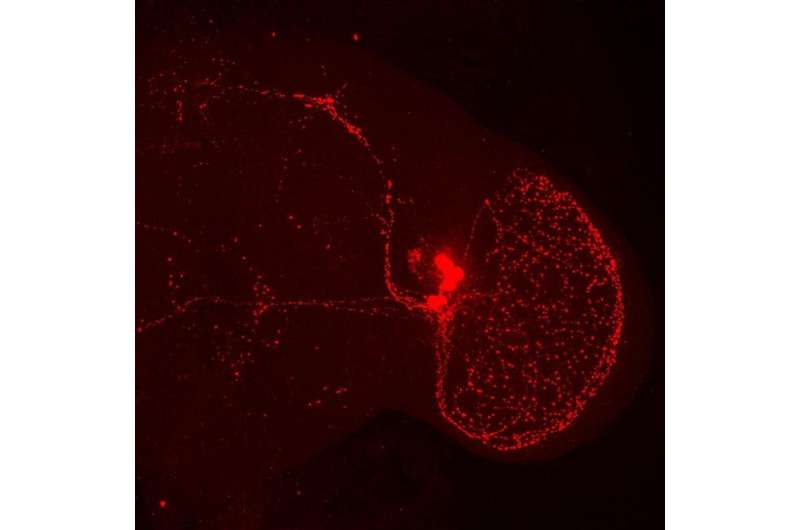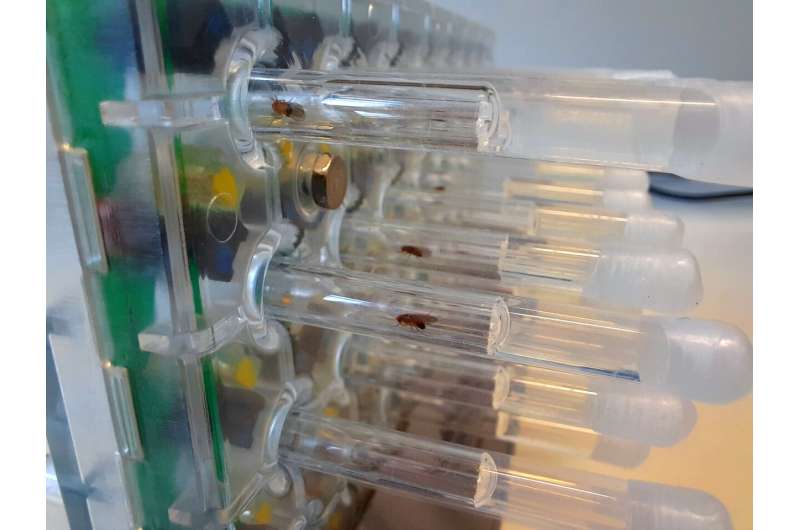
Most living organisms have an internal clock which, among other things, controls the sleep-wake rhythm. The internal rhythm lasts approximately one day (circadian), i.e. about 24 hours, and is regulated by means of various clock genes. There is also permanent coordination with factors such as light and temperature for synchronizing the internal clock with the external day-night rhythm. A team led by neurobiologist Prof. Ralf Stanewsky from the University of Münster has now demonstrated in the Drosophila melanogaster fruit fly that a certain ion transport protein (KCC) plays a role in regulating circadian rhythms by means of light.
The ion transport protein examined is part of a molecular signaling cascade in certain neurons in the brain. The background is as follows: a protein known as Quasimodo is involved in the regulation of the internal clock of the fruit fly. It is part of the cell membrane and helps to pass on light signals as external regulators and trigger an internal molecular regulatory cascade. Quasimodo interacts with a sodium-potassium-chloride cotransporter called NKCC. Its function is to transport chloride ions into the cell. In this new study, published in the journal Current Biology, the researchers examined, for the first time, the counterpart of NKCC—the potassium chloride cotransporter KCC, which transports chloride ions out of the cell.
The balance between these two cotransporters determines the chloride content in the cell. And this, in turn, is decisive for the functioning of the internal clock: the chloride content determines how a neuron reacts to the neurotransmitter GABA. When there is a high chloride content, GABA has a stimulating effect; when the content is low, it inhibits signal transmission through the cell. "One and the same signal can act as a stimulator or an inhibitor," explains lead author Katharina Eick. "It is assumed that it depends for example on the time of day—and it might explain different behaviors in the fly by day and by night." The activity of the cotransporter is regulated by two enzymes, the kinases "Wnk" and "Fray." The researchers also took a close look at these two kinases.
"What is interesting," says Eick, "is that the two cotransporters NKCC and KCC, as well as the kinases Wnk and Fray are—from an evolutionary point of view—very old proteins which occur not only in flies, but also in mammals. It was already known in the case of mammals—but not of flies—that the activity of NKCC and its counterpart plays an important role in the internal clock.

The results of the study in detail: the team demonstrated that flies in which one of the three influencing factors examined is particularly active or inactive show an abnormal rhythmic behavior under constant light. Normally, flies have no behavioral rhythm in constant light conditions as there is one essential protein in the molecular clock which is degraded in light, thus disturbing the function of the clock. "From our experiment we can conclude that KCC, Wnk and Fray are involved in a signaling pathway through which light stimuli are transferred to the internal clock," Katharina Eick explains.
In addition to the abnormal rhythmic behavior in constant light, the researchers also noticed another conspicuous behavior in some flies which were exposed to a long day-night cycle (16 hours light, eight hours dark): abnormally high activity in the morning. This heightened activity only occurred when less NKCC and less Quasimodo were present than normal. "The results indicate that the proteins we examined might have a function in the adaptation of the circadian clock to the different seasons with days of different lengths," Eick adds. "There are already indications of this in mammals." The team also demonstrated, for the first time, that the ion transport protein KCC can directly influence the neuronal response to the neurotransmitter GABA within the fruit fly's circadian clock.
Methodology: The researchers used a combination of behavioral experiments, electrophysiology and modern genetic methods. Using cell-specific genetic manipulations, they produced strains of fly in which the proteins examined were overexpressed, downregulated or absent. The activity of the neurons in the brain was measured at the so-called large ventrolateral clock neurons in the fruit fly's brain.
Complete image line (motif experimental setup): Experimental set-up for automated measurement of the activity of fruit flies: In each of the glass tubes there is a fly. When it walks back and forth, it interrupts an infrared beam, which is recorded by a sensor. The number of interruptions is considered a measure of activity. During the measurements, external conditions such as light and temperature are closely monitored.
Provided by Westfälische Wilhelms-Universität Münster
Citation: New findings on the internal clock of the fruit fly (2022, March 21) retrieved 21 March 2022 from https://ift.tt/F2K4wZz
This document is subject to copyright. Apart from any fair dealing for the purpose of private study or research, no part may be reproduced without the written permission. The content is provided for information purposes only.
"fruit" - Google News
March 21, 2022 at 06:33PM
https://ift.tt/F2K4wZz
New findings on the internal clock of the fruit fly - Phys.org
"fruit" - Google News
https://ift.tt/x2fk1lN
https://ift.tt/TYRNtGI
Bagikan Berita Ini














0 Response to "New findings on the internal clock of the fruit fly - Phys.org"
Post a Comment